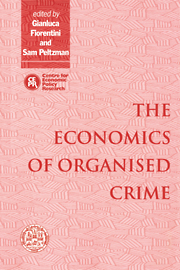Book contents
- Frontmatter
- Contents
- List of figures
- List of tables
- Foreword
- Acknowledgements
- List of conference participants
- 1 Introduction
- PART I THEORIES OF THE STATE AND THE ORIGIN OF CRIMINAL ORGANISATIONS
- PART II THE CRIMINAL ORGANISATION AS A FIRM
- PART III ORGANISED CRIME AND STATE INTERVENTION IN THE ECONOMY
- 6 Rival kleptocrats: the mafia versus the state
- Discussion
- 7 Corruption: arm's-length relationships and markets
- Discussion
- PART IV DETERRENCE POLICIES AGAINST LEGAL FIRMS INVOLVED IN ILLEGAL ACTIVITIES
- PART V DETERRENCE POLICIES AGAINST ORGANISED CRIME
- Index
Discussion
Published online by Cambridge University Press: 04 August 2010
- Frontmatter
- Contents
- List of figures
- List of tables
- Foreword
- Acknowledgements
- List of conference participants
- 1 Introduction
- PART I THEORIES OF THE STATE AND THE ORIGIN OF CRIMINAL ORGANISATIONS
- PART II THE CRIMINAL ORGANISATION AS A FIRM
- PART III ORGANISED CRIME AND STATE INTERVENTION IN THE ECONOMY
- 6 Rival kleptocrats: the mafia versus the state
- Discussion
- 7 Corruption: arm's-length relationships and markets
- Discussion
- PART IV DETERRENCE POLICIES AGAINST LEGAL FIRMS INVOLVED IN ILLEGAL ACTIVITIES
- PART V DETERRENCE POLICIES AGAINST ORGANISED CRIME
- Index
Summary
Corruption is an excellent example of issues which lend themselves to a multi-faceted approach, i.e. an analysis based on economic as well as historical, political and sociological roots. Vito Tanzi's paper probes the theoretical underpinnings of this fairly new methodology. This is no surprise given the well-known expertise of Tanzi in related issues (e.g. underground economies).
According to Tanzi, the weakness (or the absence) of arm's-length relationships – due to history and culture – makes corruption somehow endemic in some communities, and this undermines the traditional tasks assigned to public intervention in the economy: allocation, redistribution, stabilisation. Following Stiglitz's (1989) characterisation of the distinctive features of the state as economic organisation, one can also argue that corruption weakens the universal membership of citizens and represents an abuse of its power of compulsion.
In my comments I will try to cover briefly two issues. First, what can be done to eliminate, or at least mitigate, the size of corruption? Second, what do we know about the demand for corruption?
As for the first problem, we are aware that corruption exists also outside the state organisations (e.g. in the market system and within private organisations) and we also know that such practices are fairly established and firmly rooted in many screening mechanisms, as Tanzi convincingly argues. This seems to suggest that the state faces a twofold problem. On the one hand, it should minimise its presence wherever market forces work sufficiently well, i.e. where rankings are not based on significant degrees of corruption. On the other, it should protect individuals that would be damaged in biased (via corruption) organisations (schools, hospitals, firms and so on).
- Type
- Chapter
- Information
- The Economics of Organised Crime , pp. 181 - 182Publisher: Cambridge University PressPrint publication year: 1996



